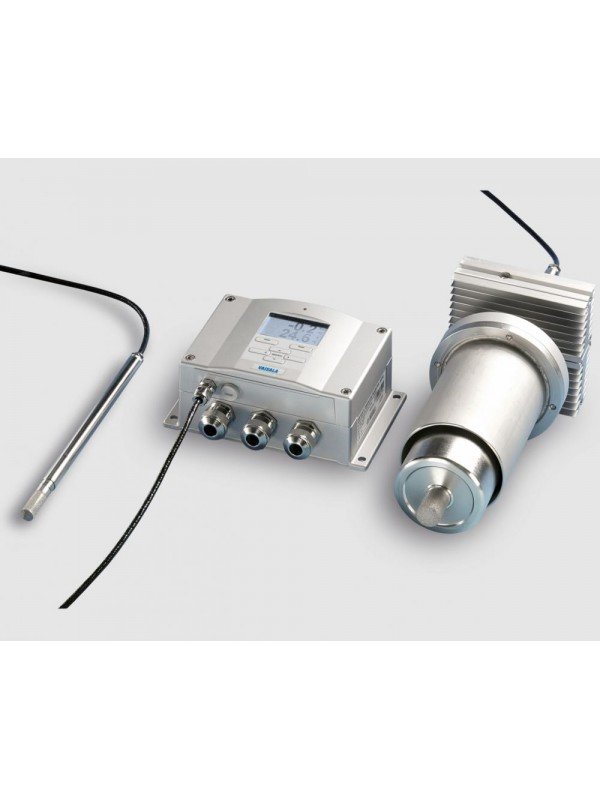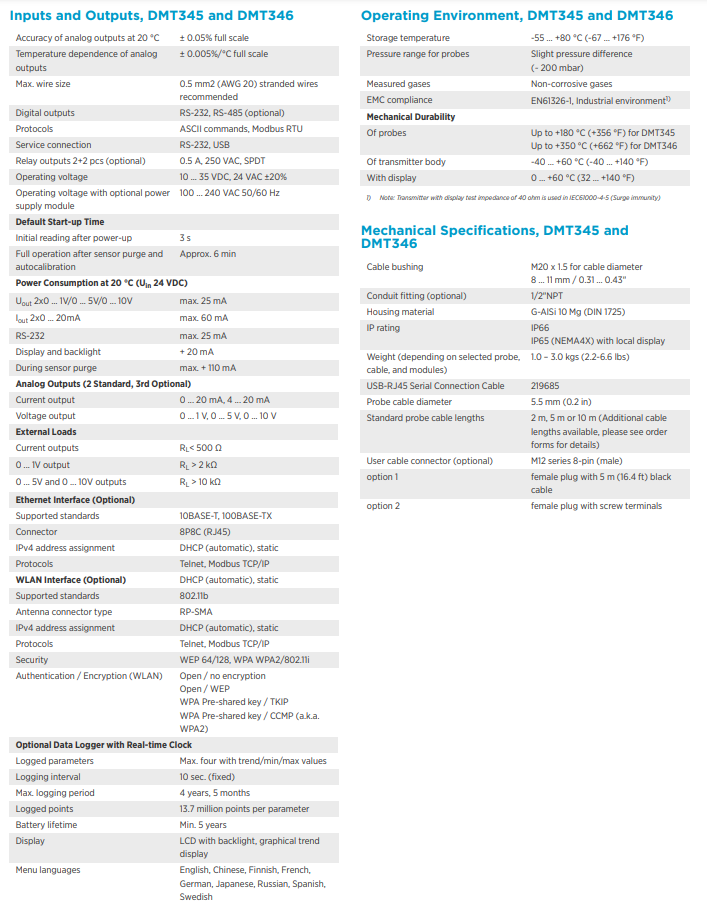

The Vaisala DRYCAP® Dewpoint Transmitters DMT345 and DMT346 are designed for humidity measurement in industrial drying applications with particularly high temperatures. The high temperature tolerance of the sensor allows direct measurement from hot process without the need for a sampling system and sample conditioning. The wide dynamic rage of the measurement in DMT345 and DMT346 is unique: Measurements can be made from -40 °C frost point up to +100 °C dew point, with dry-bulb temperatures ranging up to 350 °C.
|
Vaisala Official Distributor in Humidity, Dewpoint, Continuous Monitoring System (CMS) viewLinc (2015), Temperature, CO2, Barometric Pressure, Moisture in Oil, Wind etc in Malaysia since 1990s |
|
Please click here to visit its successor Indigo Transmitter Series: Indigo510, Indigo520 |
The equivalents for the DMT340 series: DMT345 for high pressure is now DMP5 + INDIGO500 transmitter DMT346 for very high temperature is now DMP6 + INDIGO500 transmitter |
|
Vaisala Dewpoint Transmitter DMT345 and DMT346 incorporate the Vaisala DRYCAP® sensor, which is accurate, reliable, and stable. The sensor is condensation-resistant and is immune to particulate contamination, oil vapor, and most chemicals. The DRYCAP® sensor is notable for its swift response time and rapid recovery after getting wet. DMT345: Accurate in Hot and Dry EnvironmentsDMT345 is designed for accurate humidity measurement in hot and dry conditions. This model provides unmatched dry-end measurement accuracy at temperatures up to 140 °C; however, it can operate safely at temperatures up to 180 °C. The long and robust steel probe and an optional installation flange allow easy, adjustable installation depth through insulation for example in ovens. DMT346: Reliable in Very Hot ProcessesDMT346 provides the best measurement performance at process temperatures between 140 °C and 350 °C. DMT346 includes a cooling set as standard. The cooling set provides passive cooling by conducting heat away from the probe and thus reduces temperature to optimal range for the sensor. The cooling system has no moving parts, and requires no additional power or cooling utilities, so there is no risk of |
Related Articles |
|
|
 |
 |
 |
 |
Download |
.
The Vaisala Dewpoint, Pressure and Temperature Multiparameter Transmitter DPT145 for SF6 Gas is a unique innovation that enables online measurement of dew point, pressure, and temperature. It also calculates four other values, including SF6 density. The DPT145 is especially well suited for integration into OEM systems.
- First transmitter to offer online measurement of seven SF6 parameters in one unit
- Measured parameters: dew point, pressure, temperature
- Calculated parameters: SF6 density, normalized pressure, dew point in atmospheric pressure, ppm
- Saves time and money across the board, from investment and installation to operation and servicing
- More reliable assessment of the condition of SF6 insulation due to online measurement
- Long calibration interval of years
for Vaisala's Smart Humidity, Temperature, Dew Point, Moisture in Oil, CO2 and H2O2 Probes
Vaisala Indigo200 Series host devices are part of Vaisala Indigo product family and intended for Vaisala's intelligent, stand-alone humidity probes (HMP1, HMP3, HMP4, HMP5, HMP7, HMP8 and HMP9), dew point probes (DMP5, DMP6, DMP7 and DMP8), temperature probe (TMP1), CO2 probes (GMP251 and GMP252), moisture in oil probe MMP8, as well as our vaporized hydrogen peroxide probe series HPP270: including HPP271 to measure hydrogen peroxide vapor (ppm), or the HPP272 to measure hydrogen peroxide vapor (ppm), temperature, and humidity (relative humidity and relative saturation). The HPP272 probe includes other calculated parameters such as dew point and vapor pressure measurements..
Looking for a transmitter with a metal enclosure? See Indigo500 series with dual-probe support and many more additional features.
Typical applications for the Indigo200 include industrial and compressed air drying, life science incubators, hatchers and setters, greenhouses, cold storage & refrigeration, food transportation, CO2 safety, hydraulic and lubrication oil monitoring, demanding HVAC such as animal shelters, swimming pools, parking garages, and facilities using vaporized hydrogen peroxide decontamination.
Vaisala Indigo 200 allows for easy evaluation and visualization of data, also wirelessly. The installation is uncomplicated, which saves time. Watch video on how to install Indigo201 and configure analog outputs. Also the probe types are interchangeable reducing downtime. The enclosure with an IP65 classification is safe for harsh environments and resistant to dust and most chemicals. The smooth surface of the enclosure makes cleaning easy.
Vaisala DRYCAP® Dew Point and Temperature Probe DMP5 is designed for in-line humidity measurement in industrial drying applications with high temperatures and a wide dew point range. The long and robust steel probe and optional installation flange allow easy installation with adjustable depth to reach through insulation, for example in ovens.
Vaisala DMP5 incorporates the Vaisala DRYCAP® sensor, which is accurate, reliable, and stable. The sensor is condensation-resistant and immune to particulate contamination, oil vapor, and most chemicals. Sensor warming minimizes the risk of condensation accumulating on the sensor. If the DRYCAP® sensor does get wet, it dries rapidly and recovers its swift response time. In low-humidity conditions the sensor will auto-calibrate to ensure accurate measurement.
Vaisala DMP5 is part of the Indigo family and is compatible with the Indigo500 and Indigo200 series transmitters. It can be used with Vaisala Insight PC software for data visualization, easy probe configuration, and self-calibration.
Vaisala Indigo300 Transmitter is a host device for displaying measurement values from Vaisala Indigo-compatible probes and/or transmitting them to automation systems through analog signals.
Vaisala DRYCAP® Dew Point and Temperature Probe DMP6 is designed for in-line humidity measurement in industrial drying applications with very high temperatures and a wide dew point range. A high temperature tolerance is achieved using a passive cooling set that conducts heat away from the probe and reduces the temperature to within the optimal range for the sensor.
Vaisala DMP6 incorporates the Vaisala DRYCAP® sensor, which is accurate, reliable, and stable. The sensor is condensation-resistant and immune to particulate contamination, oil vapor, and most chemicals. Sensor warming minimizes the risk of condensation accumulating on the sensor. If the DRYCAP® sensor does get wet, it dries rapidly and recovers its swift response time. In low-humidity conditions the sensor will auto-calibrate to ensure accurate measurement.
Vaisala DMP6 is part of the Indigo family and is compatible with Indigo500 and Indigo200 series transmitters. It can be used with the Vaisala Insight PC software for data visualization, easy probe configuration, and self-calibration.
Vaisala Dewpoint Transmitter DMT132 is an affordable dew point measurement instrument designed to verify the functionality of refrigerant dryers. The probe has excellent long-term stability and it is resistant to compressor oil. It is especially well suited for OEM dryer manufacturers.
Vaisala HUMICAP® Dewpoint Transmitter DMT132 is an affordable dew point measurement instrument designed to verify the functionality of refrigerant dryers. The probe has excellent long-term stability and it is resistant to compressor oil. It is especially well suited for OEM dryer manufacturers.
Vaisala DRYCAP® Dew Point and Temperature Probe DMP7 is made for tight spaces and low-humidity applications. Its short probe length makes it suitable for installations that have limited space such as semiconductor manufacturing equipment. Other typical applications include industrial drying systems, compressed air systems, and dry rooms.
Vaisala DMP7 is part of the Indigo family and is compatible with Indigo500 and Indigo200 series transmitters. It can be used with the Vaisala Insight PC software for data visualization, easy probe configuration, and self-calibration.
The Vaisala Dewpoint and Pressure Transmitter DPT146 for Compressed Air makes monitoring compressed air simple and convenient. The Vaisala Dewpoint Transmitter for Compressed Air DPT146 measures both dew point and process pressure simultaneously, and is the ideal choice for anyone using or monitoring compressed air.
- The first transmitter that monitors both dew point and process pressure
- A simple and convenient transmitter for monitoring of compressed air
- Highly accurate humidity information thanks to online pressure-compensated dew point data
- Proven sensor technology
- Compatible with the Vaisala Hand-Held DM70 for easy spot checking, local - display and data logging
- Pressure: 1…10 bar
- Dew point: -60 ... +30 °C
Vaisala Miniature size dew point transmitters DMT143 and DMT143L are ideal choices when you want to measure dew point accurately in small compressed air dryers, plastic dryers, additive manufacturing and other OEM applications. They are easy to integrate and can be used in Vaisala DM70 hand-held. The long version has replaced the DMT242.
The Vaisala Indigo, Indigo 510, Indigo 520 transmitter has 4 analog channels that can be configured to mA or voltage type and 2 configurable relays. The Vaisala Indigo510 has 2 analog channels. Any of the output parameters from the connected probes can be assigned to control the analog channels and relays. Digital output protocol is Modbus TCP/IP over Ethernet. Besides Modbus TCP/IP, the transmitter's Ethernet connection provides a web interface and cyber-security that meets the modern standards
The touchscreen display provides local data visualization and easy access to probe configuration. The transmitter also extends the options for connectivity, supply voltage and wiring, compared to using just a smart probe. It also provides mechanical support when wall-mount probe installation is preferred. Rugged IP66- and NEMA4-rated metal enclosure ensures reliable performance even in the harshest conditions.
The Indigo-compatible smart probes include humidity probes (HMP1, HMP3, HMP4, HMP5, HMP7, HMP8 and HMP9), dew point probes (DMP5, DMP6, DMP7 and DMP8), carbon dioxide probes (GMP251 and GMP252), moisture in oil probe (MMP8), temperature probe (TMP1), and vaporized hydrogen peroxide probes (HPP270). The Indigo520 is also compatible with MHT410 Moisture, Hydrogen and Temperature Transmitter for power transformer online monitoring
The Indigo520 dual-probe support allows simultaneous measurements with two Vaisala Indigo-compatible probes for humidity, temperature, dew point temperature, carbon dioxide, vaporized hydrogen peroxide, and moisture in oil measurements. If you need just one probe, the Indigo510 is an ideal choice.
Vaisala DRYCAP® Dew Point and Temperature Probe DMP8 is designed for industrial low-humidity applications with pressure up to 40 bars. Typical applications include industrial drying, compressed air systems, and applications in the semiconductor industry.
Vaisala DMP8 can be installed in a 1/2" NPT or ISO thread with adjustable insertion depth. An optional ball-valve installation kit allows the probe to be inserted or detached from a pressurized line.
Vaisala DMP8 is part of theIndigo family and is compatible with Indigo500 and Indigo200 series transmitters. It can be used with the Vaisala Insight PC software for data visualization, easy probe configuration, and self-calibration.
The Vaisala DRYCAP® Dewpoint Transmitter DMT152 is designed for measuring low dew point in OEM applications, even down to -80°C. The excellent long-term stability and reliability of its performance is based on the latest DRYCAP® polymer sensor technology. The DMT152 is an ideal choice for industrial applications where it is necessary to control very low humidity.
DMT152 is an ideal choice for the semiconductor industry, air and plastics dryers, glove boxes, dry chambers, pure gases, additive manufacturing, high voltage circuit breakers and other applications where it is critical to control humidity with high accuracy. DMT152 measures accurately and reliably also in the challenging combination of low humidity and hot air, which is typical in plastics drying.

The Vaisala DRYCAP® Dewpoint Transmitters DMT345 and DMT346 are designed for humidity measurement in industrial drying applications with particularly high temperatures. The high temperature tolerance of the sensor allows direct measurement from hot process without the need for a sampling system and sample conditioning. The wide dynamic rage of the measurement in DMT345 and DMT346 is unique: Measurements can be made from -40 °C frost point up to +100 °C dew point, with dry-bulb temperatures ranging up to 350 °C.




